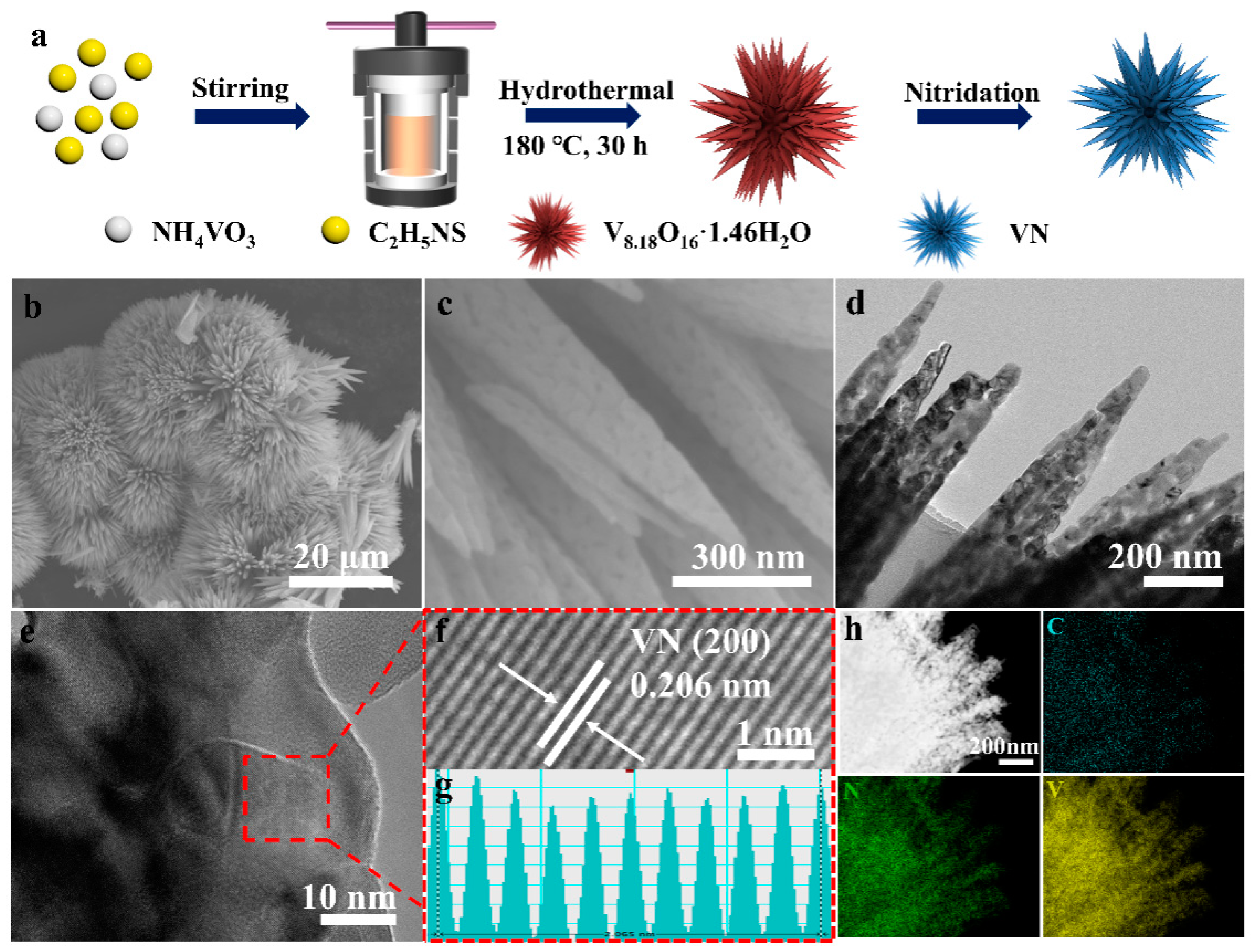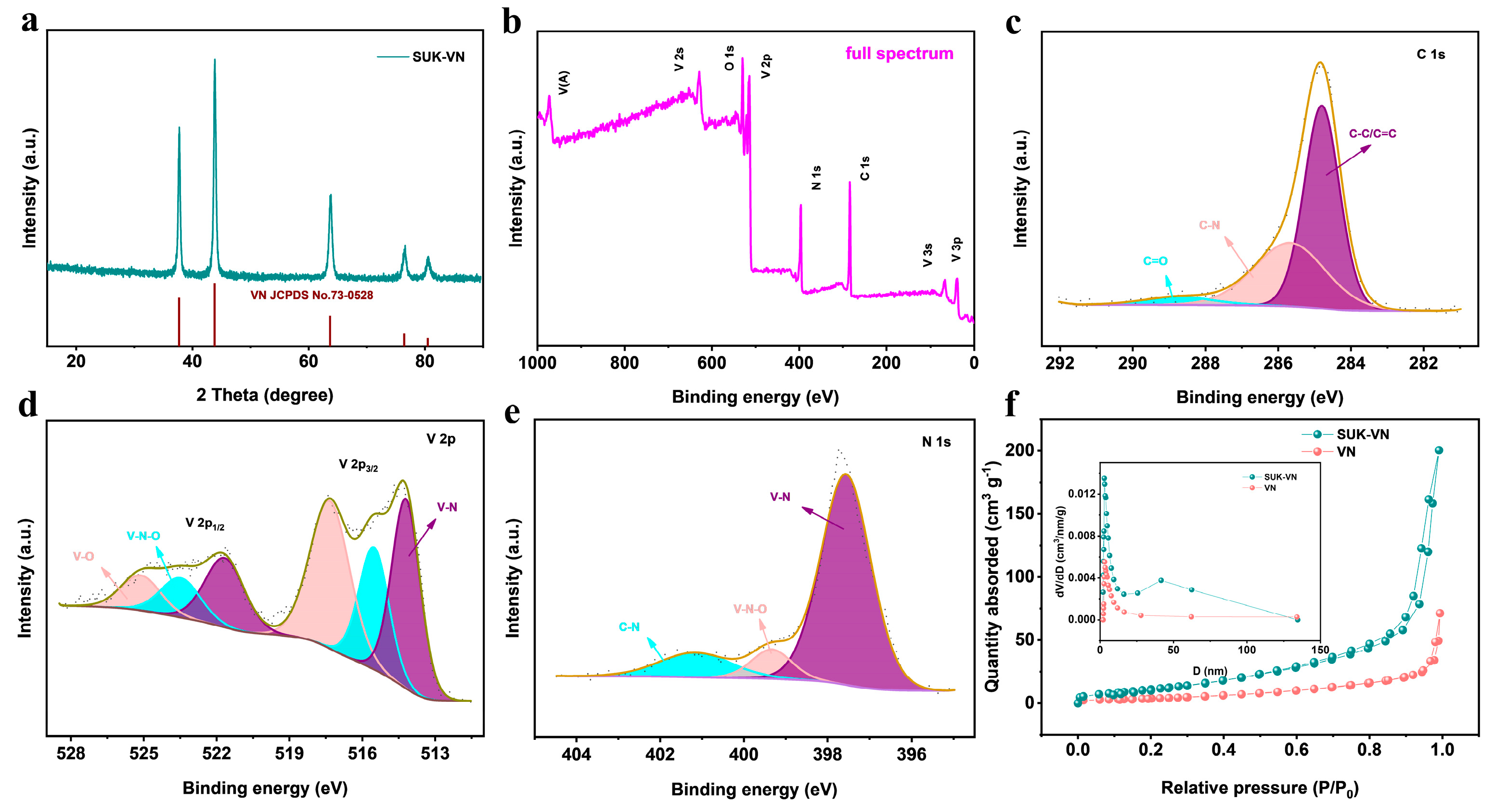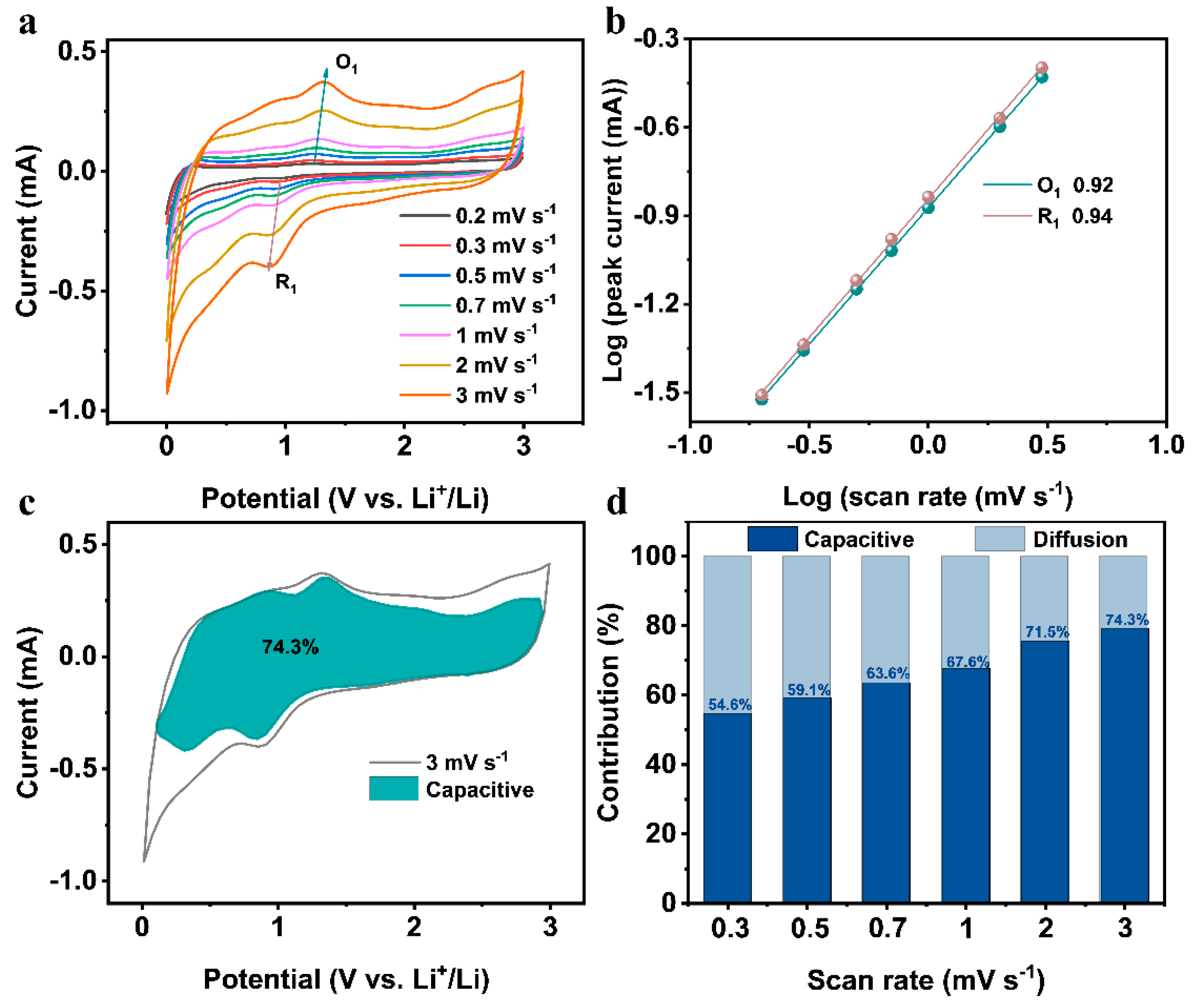Facile Synthesis of Sea-Urchin-like VN as High-Performance Anode for Lithium-Ion Batteries
Abstract
:1. Introduction
2. Materials and Methods
2.1. Synthesis of SUK-VN Composite
2.2. Characterization
2.3. Electrochemical Measurement
3. Results and Discussion
4. Conclusions
Supplementary Materials
Author Contributions
Funding
Data Availability Statement
Conflicts of Interest
References
- Chen, S.; Ma, J.; Song, C.; Cai, X.; Jiao, F.; Du, H. Template-free synthesis of flower-like hierarchical vanadium nitride/carbon composites for long cycle-life half and full lithium-ion batteries. J. Power Sources 2022, 520, 230924. [Google Scholar] [CrossRef]
- Sun, C.; Qu, A.; Zhang, J.; Shi, Q.; Jia, Z. Remaining Useful Life Prediction for Lithium-Ion Batteries Based on Improved Variational Mode Decomposition and Machine Learning Algorithm. Energies 2022, 16, 313. [Google Scholar] [CrossRef]
- Wang, K.; Zhang, R.; Guo, Y.; Liu, Y.; Tian, Y.; Wang, X.; Wang, P.; Liu, Z. One-Step Construction of Co2P Nanoparticles Encapsulated into N-Doped Porous Carbon Sheets for Efficient Oxygen Evolution Reaction. Energies 2023, 16, 478. [Google Scholar] [CrossRef]
- Yang, L.; Cao, X.; Wang, X.; Wang, Q.; Jiao, L. Regulative electronic redistribution of CoTe2/CoP heterointerfaces for accelerating water splitting. Appl. Catal. B Environ. 2023, 329, 122551. [Google Scholar] [CrossRef]
- Li, W.; Wang, N.; Wang, H.; Yang, Z.; Yang, H.; Zhang, J.; Yuan, Y.; Wang, J.; Pei, J.; Li, X. Progress and Opportunities of Vanadium-Based Compounds as Cathode Hosts, Decoration Layers of Separators, and Interlayers in Lithium Sulfur Batteries. Cryst. Growth Des. 2022, 22, 5694–5725. [Google Scholar] [CrossRef]
- Wang, J.; Yang, C.; Wu, J.; Zhang, L.; Wei, M. Facile synthesis of VN hollow spheres as an anode for lithium-ion battery. J. Electroanal. Chem. 2019, 848, 113360. [Google Scholar] [CrossRef]
- Liu, R.J.; Yang, L.X.; Wang, W.J.; Liu, H.J.; Zeng, C.L. Molten salt disproportionation synthesis of nanosized VN wrapped onto carbon fibers with enhanced lithium-ion storage capabilities. J. Alloys Compd. 2022, 919, 165796. [Google Scholar] [CrossRef]
- Park, J.-S.; Wang, S.E.; Jung, D.S.; Lee, J.-K.; Kang, Y.C. Nanoconfined vanadium nitride in 3D porous reduced graphene oxide microspheres as high-capacity cathode for aqueous zinc-ion batteries. Chem. Eng. J. 2022, 446, 137266. [Google Scholar] [CrossRef]
- Dong, Y.; Du, X.-Q.; Liang, P.; Man, X.-L. One-pot solvothermal method to fabricate 1D-VS4 nanowires as anode materials for lithium ion batteries. Inorg. Chem. Commun. 2020, 115, 107883. [Google Scholar] [CrossRef]
- Li, N.; Xu, Z.; Wang, P.; Zhang, Z.; Hong, B.; Li, J.; Lai, Y. High-rate lithium-sulfur batteries enabled via vanadium nitride nanoparticle/3D porous graphene through regulating the polysulfides transformation. Chem. Eng. J. 2020, 398, 125432. [Google Scholar] [CrossRef]
- Feng, M.; Wang, W.; Hu, Z.; Fan, C.; Zhao, X.; Wang, P.; Li, H.; Yang, L.; Wang, X.; Liu, Z. Engineering chemical-bonded Ti3C2 MXene@carbon composite films with 3D transportation channels for promoting lithium-ion storage in hybrid capacitors. Sci. China Mater. 2023, 66, 944–954. [Google Scholar] [CrossRef]
- Qu, L.; Liu, P.; Tian, X.; Shu, C.; Yi, Y.; Yang, P.; Wang, T.; Fang, B.; Li, M.; Yang, B. VN/S Nanoclusters Encapsulated with Graphene via Zeta Potential Control: A Pomegranate-like Cathode for Lithium-Sulfur Batteries with Enhanced Rate Performance. ChemElectroChem 2020, 7, 1679–1688. [Google Scholar] [CrossRef]
- Song, W.; Xu, C.; Li, M.; Cheng, Z.; Liu, Y.; Wang, P.; Liu, Z. Cobalt Nanocluster-Doped Carbon Micro-Spheres with Multilevel Porous Structure for High-Performance Lithium-Sulfur Batteries. Energies 2022, 16, 247. [Google Scholar] [CrossRef]
- Wu, Y.; Ran, F. Vanadium nitride quantum dot/nitrogen-doped microporous carbon nanofibers electrode for high-performance supercapacitors. J. Power Sources 2017, 344, 1–10. [Google Scholar] [CrossRef]
- Jing, E.; Chen, L.; Xu, S.; Tian, W.; Zhang, D.; Wang, N.; Bai, Z.; Zhou, X.; Liu, S.; Duan, D.; et al. Dual redox catalysis of VN/nitrogen-doped graphene nanocomposites for high-performance lithium-sulfur batteries. J. Energy Chem. 2022, 64, 574–582. [Google Scholar] [CrossRef]
- Li, F.; Zhang, M.; Chen, W.; Cai, X.; Rao, H.; Chang, J.; Fang, Y.; Zhong, X.; Yang, Y.; Yang, Z.; et al. Vanadium Nitride Quantum Dots/Holey Graphene Matrix Boosting Adsorption and Conversion Reaction Kinetics for High-Performance Lithium-Sulfur Batteries. ACS Appl. Mater. Interfaces 2021, 13, 30746–30755. [Google Scholar] [CrossRef]
- Wang, W.; Feng, M.; Hu, E.; Hu, Z.; Fan, C.; Li, H.; Wang, P.; Wang, X.; Liu, Z. Interlayer and intralayer co-modified flexible V2CTX MXene@SWCNT films for high-power Li-ion capacitors. J. Energy Chem. 2023, 79, 101–109. [Google Scholar] [CrossRef]
- Song, N.; Xi, B.; Wang, P.; Ma, X.; Chen, W.; Feng, J.; Xiong, S. Immobilizing VN ultrafine nanocrystals on N-doped carbon nanosheets enable multiple effects for high-rate lithium—Sulfur batteries. Nano Res. 2021, 15, 1424–1432. [Google Scholar] [CrossRef]
- Zhao, D.; Qin, J.; Zheng, L.; Guo, D.; Wang, J.; Cao, M. Covalent interfacial coupling of vanadium nitride with nitrogen-rich carbon textile boosting its lithium storage performance as binder-free anode. Nano Res. 2021, 14, 4336–4346. [Google Scholar] [CrossRef]
- Jia, H.; Cai, Y.; Li, S.; Zheng, X.; Miao, L.; Wang, Z.; Qi, J.; Cao, J.; Feng, J.; Fei, W. In situ synthesis of core-shell vanadium nitride@N-doped carbon microsheet sponges as high-performance anode materials for solid-state supercapacitors. J. Colloid Interface Sci. 2020, 560, 122–129. [Google Scholar] [CrossRef]
- Bai, Y.; Zhang, H.; Xiang, B.; Yao, Q.; Dou, L.; Dong, G. Engineering porous structure in Bi-component-active ZnO quantum dots anchored vanadium nitride boosts reaction kinetics for zinc storage. Nano Energy 2021, 89, 106386. [Google Scholar] [CrossRef]
- Xu, L.; Xiong, P.; Zeng, L.; Liu, R.; Liu, J.; Luo, F.; Li, X.; Chen, Q.; Wei, M.; Qian, Q. Facile fabrication of a vanadium nitride/carbon fiber composite for half/full sodium-ion and potassium-ion batteries with long-term cycling performance. Nanoscale 2020, 12, 10693–10702. [Google Scholar] [CrossRef]
- Yu, S.; Sun, Y.; Song, L.; Cao, X.; Chen, L.; An, X.; Liu, X.; Cai, W.; Yao, T.; Song, Y.; et al. Vanadium atom modulated electrocatalyst for accelerated Li S chemistry. Nano Energy 2021, 89, 106414. [Google Scholar] [CrossRef]
- Ou, L.; Liu, Z.; Zhou, Y.; Ou, H.; Zhu, J.; Cao, X.; Fang, G.; Zhou, J.; Liang, S. Pseudocapacitance-dominated zinc storage enabled by nitrogen-doped carbon stabilized amorphous vanadyl phosphate. Chem. Eng. J. 2021, 426, 131868. [Google Scholar] [CrossRef]
- Meng, X.; Li, Z.; Cheng, Z.; Li, P.; Wang, R.; Li, X. Ammonia-free fabrication of ultrafine vanadium nitride nanoparticles as interfacial mediators for promoting electrochemical behaviors of lithium-sulfur batteries. Nanoscale 2021, 13, 5292–5299. [Google Scholar] [CrossRef]
- Wang, H.; Li, J.; Li, K.; Lin, Y.; Chen, J.; Gao, L.; Nicolosi, V.; Xiao, X.; Lee, J.M. Transition metal nitrides for electrochemical energy applications. Chem. Soc. Rev. 2021, 50, 1354–1390. [Google Scholar] [CrossRef]
- Ma, L.; Yuan, H.; Zhang, W.; Zhu, G.; Wang, Y.; Hu, Y.; Zhao, P.; Chen, R.; Chen, T.; Liu, J.; et al. Porous-Shell Vanadium Nitride Nanobubbles with Ultrahigh Areal Sulfur Loading for High-Capacity and Long-Life Lithium-Sulfur Batteries. Nano Lett. 2017, 17, 7839–7846. [Google Scholar] [CrossRef]
- Zeng, F.; Lu, T.; He, W.; Chu, S.; Qu, Y.; Pan, Y. In-situ carbon encapsulation of ultrafine VN in yolk-shell nanospheres for highly reversible sodium storage. Carbon 2021, 175, 289–298. [Google Scholar] [CrossRef]
- Li, C.; Zhu, L.; Qi, S.; Ge, W.; Ma, W.; Zhao, Y.; Huang, R.; Xu, L.; Qian, Y. Ultrahigh-Areal-Capacity Battery Anodes Enabled by Free-Standing Vanadium Nitride@N-Doped Carbon/Graphene Architecture. ACS Appl. Mater. Interfaces 2020, 12, 49607–49616. [Google Scholar] [CrossRef]
- Zhang, J.-H.; Chen, Z.-Y.; Xu, T.-Z.; Ai, L.-F.; Xu, Y.-H.; Zhang, X.-G.; Shen, L.-F. Vanadium nitride nanoparticles embedded in carbon matrix with pseudocapacitive behavior for high performance lithium-ion capacitors. Rare Met. 2022, 41, 2460–2469. [Google Scholar] [CrossRef]
- Liu, X.; Li, G.; Wu, J.; Meng, L.; Zhang, D.; Zhang, X.; Li, L. VN nanocrystals on N, S co-doped carbon framework: Topochemical self-nitridation and superior performance for lithium-ion battery. Electrochim. Acta 2022, 429, 140982. [Google Scholar] [CrossRef]
- Wang, R.; Lang, J.; Zhang, P.; Lin, Z.; Yan, X. Fast and Large Lithium Storage in 3D Porous VN Nanowires-Graphene Composite as a Superior Anode Toward High-Performance Hybrid Supercapacitors. Adv. Funct. Mater. 2015, 25, 2270–2278. [Google Scholar] [CrossRef]
- Peng, T.; Guo, Y.; Zhang, Y.; Wang, Y.; Zhang, D.; Yang, Y.; Lu, Y.; Liu, X.; Chu, P.K.; Luo, Y. Uniform cobalt nanoparticles-decorated biscuit-like VN nanosheets by in situ segregation for Li-ion batteries and oxygen evolution reaction. Appl. Surf. Sci. 2021, 536, 147982. [Google Scholar] [CrossRef]
- Huang, J.; Lu, X.; Sun, T.; Yu, D.; Xu, Z.; Xie, Y.; Jiang, X.; Wang, Y.; Wang, S.; Zhang, X.; et al. Boosting High-Voltage Dynamics Towards High-Energy-Density Lithium-Ion Capacitors. Energy Environ. Mater. 2022, e12505. [Google Scholar] [CrossRef]
- Liu, W.; An, Y.; Wang, L.; Hu, T.; Li, C.; Xu, Y.; Wang, K.; Sun, X.; Zhang, H.; Zhang, X.; et al. Mechanically flexible reduced graphene oxide/carbon composite films for high-performance quasi-solid-state lithium-ion capacitors. J. Energy Chem. 2023, 80, 68–76. [Google Scholar] [CrossRef]
- Long, B.; Balogun, S.; Luo, L.; Luo, Y.; Qiu, W.; Song, S.; Zhang, L.; Tong, Y. Encapsulated vanadium-based hybrids in amorphous N-doped carbon matrix as anode materials for lithium-ion batteries. Small 2017, 13, 1702081. [Google Scholar] [CrossRef]
- Kundu, D.; Krumeich, F.; Fotedar, R.; Nesper, R. A nanocrystalline nitride as an insertion anode for Li-ion batteries. J. Power Sources 2015, 278, 608–613. [Google Scholar] [CrossRef]
- Zhang, K.; Wang, H.; He, X.; Liu, Z.; Wang, L.; Gu, L.; Xu, H.; Han, P.; Dong, S.; Zhang, C.; et al. A hybrid material of vanadium nitride and nitrogen-doped graphene for lithium storage. J. Mater. Chem. 2011, 21, 11916. [Google Scholar] [CrossRef]




Disclaimer/Publisher’s Note: The statements, opinions and data contained in all publications are solely those of the individual author(s) and contributor(s) and not of MDPI and/or the editor(s). MDPI and/or the editor(s) disclaim responsibility for any injury to people or property resulting from any ideas, methods, instructions or products referred to in the content. |
© 2023 by the authors. Licensee MDPI, Basel, Switzerland. This article is an open access article distributed under the terms and conditions of the Creative Commons Attribution (CC BY) license (https://creativecommons.org/licenses/by/4.0/).
Share and Cite
Hu, Z.; Huang, W.; Li, H.; Zhang, Y.; Wang, P.; Wang, X.; Liu, Z. Facile Synthesis of Sea-Urchin-like VN as High-Performance Anode for Lithium-Ion Batteries. Energies 2023, 16, 4816. https://doi.org/10.3390/en16124816
Hu Z, Huang W, Li H, Zhang Y, Wang P, Wang X, Liu Z. Facile Synthesis of Sea-Urchin-like VN as High-Performance Anode for Lithium-Ion Batteries. Energies. 2023; 16(12):4816. https://doi.org/10.3390/en16124816
Chicago/Turabian StyleHu, Zhaowei, Weifeng Huang, Huifang Li, Yizhou Zhang, Peng Wang, Xiaojun Wang, and Zhiming Liu. 2023. "Facile Synthesis of Sea-Urchin-like VN as High-Performance Anode for Lithium-Ion Batteries" Energies 16, no. 12: 4816. https://doi.org/10.3390/en16124816
APA StyleHu, Z., Huang, W., Li, H., Zhang, Y., Wang, P., Wang, X., & Liu, Z. (2023). Facile Synthesis of Sea-Urchin-like VN as High-Performance Anode for Lithium-Ion Batteries. Energies, 16(12), 4816. https://doi.org/10.3390/en16124816








